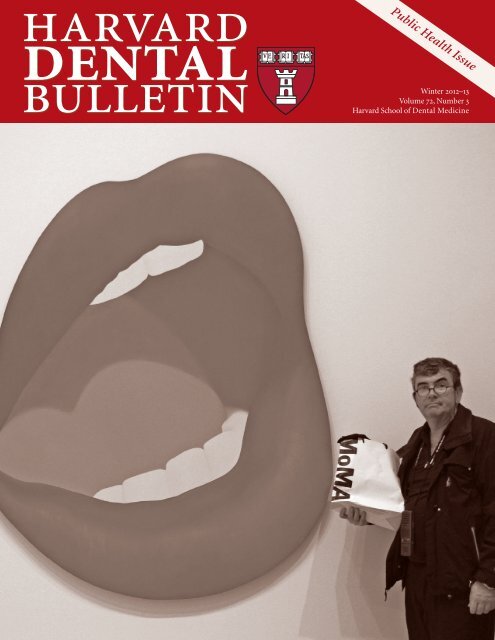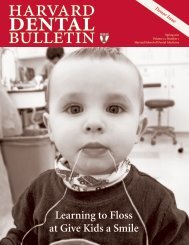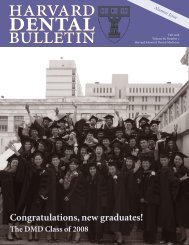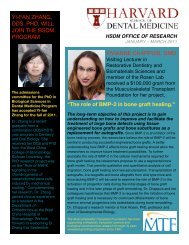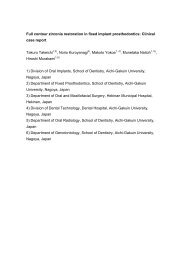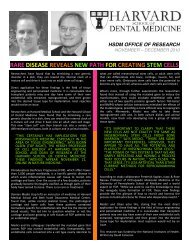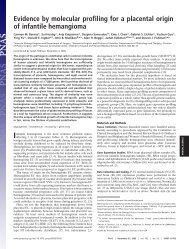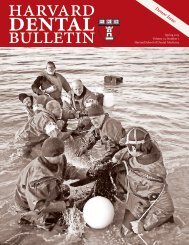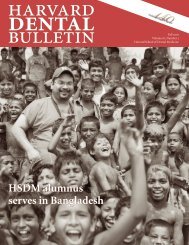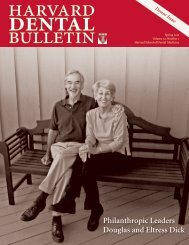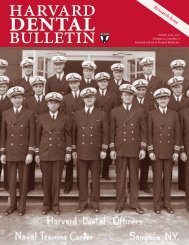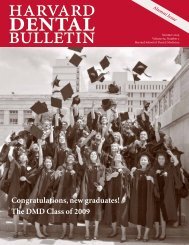Public Health Issue - Harvard School of Dental Medicine
Public Health Issue - Harvard School of Dental Medicine
Public Health Issue - Harvard School of Dental Medicine
- No tags were found...
Create successful ePaper yourself
Turn your PDF publications into a flip-book with our unique Google optimized e-Paper software.
harvarddentalbulletin<strong>Public</strong> <strong>Health</strong> <strong>Issue</strong>Winter 2012–13Volume 72, Number 3<strong>Harvard</strong> <strong>School</strong> <strong>of</strong> <strong>Dental</strong> <strong>Medicine</strong>
harvarddentalbulletinWinter 2012–13Volume 72, Number 3Editorial StaffAllen Ali Nasseh, Alumni EditorJan Reiss, Editor and DesignerEditorial CommitteeJohn Daren Da SilvaDawn DeCostaT. Howard HowellDeb MilsteinOn the cover: Richard Black, DMD84, MPH84,contemplates an “oral exam” in front <strong>of</strong> TomWesselman’s “Mouth, 7” at the Museum <strong>of</strong>Modern Art in New York City. “I love a patientwith a big mouth,” says Black. Courtesyphotograph.The <strong>Harvard</strong> <strong>Dental</strong> Bulletin is published threetimes a year for alumni and friends <strong>of</strong> the<strong>Harvard</strong> <strong>School</strong> <strong>of</strong> <strong>Dental</strong> <strong>Medicine</strong>. We lookforward to receiving your feedback and news.Please send correspondence to:Jan Reiss, PhDDirector <strong>of</strong> Communications<strong>Harvard</strong> <strong>School</strong> <strong>of</strong> <strong>Dental</strong> <strong>Medicine</strong>188 Longwood AvenueBoston, MA 02115or e-mail bulletin@hsdm.harvard.edu———A publication <strong>of</strong> the HSDM Office <strong>of</strong>Development and Alumni Relations617-432-1534———Copyright 2013<strong>Harvard</strong> <strong>School</strong> <strong>of</strong> <strong>Dental</strong> <strong>Medicine</strong>———hsdm.harvard.edu2 winter 2012–13 • harvard dental bulletin
From the DeanAs we reflect on the accomplishments <strong>of</strong> the past year with gratitude and look forwardto the coming months <strong>of</strong> 2013, the <strong>Harvard</strong> <strong>School</strong> <strong>of</strong> <strong>Dental</strong> <strong>Medicine</strong> anticipatesa year <strong>of</strong> innovation and excellence in education, research, and patient care. Indeed,exciting developments are continually taking place at HSDM.In keeping with the <strong>School</strong>’s focus on public health, HSDM has instituted a new DMDcourse, Introduction to Global Oral <strong>Health</strong>, based on a popular advanced graduateclass that was piloted last year. This discussion-based critical thinking course examinesthe extensive relationship between oral health and global health, including the ways in which global population and diseasetrends affect oral health and the association <strong>of</strong> oral diseases with a number <strong>of</strong> issues, including poverty, HIV/AIDS, maternaland child health, and lack <strong>of</strong> sanitation and clean water.HSDM researchers are engaged in studies with major implications for advancing human health, in areas such as osteoarthritis,chronic inflammatory disease, tissue engineering, cell biology, and genetics. One important study, concerning afinding that could lead to new treatments for osteoporosis, is featured in this issue <strong>of</strong> the Bulletin.As part <strong>of</strong> the <strong>School</strong>’s continuing efforts toward integrating oral health and overall health, last fall the <strong>Harvard</strong> <strong>Dental</strong>Center began conducting medical screenings to help patients understand their health. At every visit, the providers discusswith patients several health areas, including blood pressure, asthma status, weight, vaccination for pneumonia, growth (forchildren), vaccination for the flu, and smoking. We anticipate that these measures will lead to improvements in health forour dental patients. HSDM is also leading the way in standardizing dental diagnostic coding to improve patient care andcommunication among oral health pr<strong>of</strong>essionals.One focal point <strong>of</strong> HSDM is to provide free oral health screenings, education, and dental care in underserved communitiesand for vulnerable populations in the local area. All DMD students participate, whether in volunteer projects that they haveorganized under faculty supervision or through externships at community health centers across the region. Service is a tenet<strong>of</strong> the HSDM educational experience, and the knowledge students gain about the variety <strong>of</strong> patients they may encounterbenefits them immensely. Some decide to pursue careers in public health as a result.Those <strong>of</strong> you who are HSDM alumni remember what yourHSDM education meant to you as a foundation for your futureand for success in your field. Your past generosity has madethis foundation possible for aspiring oral health pr<strong>of</strong>essionalswho seek the very best in dental medicine education, and weare deeply grateful. I look forward to sharing with you the goodworks <strong>of</strong> HSDM during 2013.INSIDEalumni focus 2public health focus 6research focus 21dental school news 22Bruce Don<strong>of</strong>f, DMD67, MD73harvard dental bulletin • winter 2012–131
Anubha Sacheti, DMD05, PD06With a cardiologist father, a pediatricianmother, and a neighbor who was a dentist,Anubha Sacheti grew up surrounded by rolemodels in the health care field. Sizing up heroptions, Sacheti decided that she would pursue dentistry. “Itseemed to have the most balanced lifestyle among the healthcare pr<strong>of</strong>essions,” she says, “and I love working with my hands.”As a practicing pediatric dentist, past Massachusettsstate leader <strong>of</strong> the Head Start <strong>Dental</strong> Home Initiative <strong>of</strong> theAmerican Academy <strong>of</strong> Pediatric Dentistry (AAPD), state publicpolicy advocate for the AAPD, and the mother <strong>of</strong> two younggirls, Sacheti has her hands full these days.Sacheti came to HSDM after receiving a bachelor’sdegree from Bowdoin College. She was thus comfortable inthe environment <strong>of</strong> a small school—one reason she choseHSDM for her dental studies. It’s a decision she cherishes.“We did problem solving together,” she says <strong>of</strong> her classmates.“We had roundtable discussions. I made fantastic friendsand had mentors with whom I speak on a regular basis.”Among Sacheti’s mentors are Neda Shah-Hosseini, DMD96,a clinical instructor in restorative dentistry and biomaterialssciences at HSDM and formerly a senior tutor, who practicesin Brookline, Massachusetts. “She’s still my dentist,” saysSacheti, “and she’s an amazing person, with whom I canbounce around and explore ideas. She watches over me likea big sister.” Sacheti also cites her former teacher CatherineHayes, DMSc93, PD93 (dental public health), president-elect<strong>of</strong> the American Association <strong>of</strong> <strong>Public</strong> <strong>Health</strong> Dentistry, asa mentor from whom she continues to learn. And Sachetilauds Nina Casaverde, DMD03, a pediatric dentist in Bedford,New Hampshire, as “an awesome person. HSDM is such asmall school that one can really form long-term relationships.Students can reach out to alumni and still be in contact aftergraduation. I think HSDM is unique in this way. ”Sacheti completed her general practice residency (GPR)in 2006 through the HSDM program at Cambridge <strong>Health</strong>Alliance, where she continues to teach. She is a faculty adviserfor the HSDM student-led ACTION free-care program at theWindsor Street <strong>Health</strong> Center <strong>Dental</strong> Clinic. “I had my firsttaste <strong>of</strong> working with kids at the Windsor Street clinic duringmy residency,” she says. “I found that I loved it.” Her practicenow also includes pediatric special-needs patients.Following the GPR, Sacheti received specialty trainingin pediatric dentistry at Boston University’s Goldman <strong>School</strong>Jan ReissAnubha Sacheti, DMD05, PD06 (general practice residency), cowrotethe book Happy, <strong>Health</strong>y Teeth, designed to provide parents,especially those in the Head Start program, with information aboutthe importance <strong>of</strong> oral health care in children beginning at age one.2 winter 2012–13 • harvard dental bulletin
alumni focus<strong>of</strong> <strong>Dental</strong> <strong>Medicine</strong>, during which she had a child, Aleena, nowfour-and-a-half years old. After graduating in 2008, Sachetiwent into private practice. In 2009, she began working in theHead Start program. “I had a lot to learn about making policy,data use, and so on,” she says. “We needed more dentists to seeage-one kids. These visits are very different from the threeyear-oldvisits. Happily, we found dentists willing to learn,but we also needed pediatricians to get on board with thepreventive aspects.”To help parents and very young children get on boardas well, in 2011 Sacheti published Happy, <strong>Health</strong>y Teeth: AGuide to Children’s <strong>Dental</strong> <strong>Health</strong>, a book designed to provideaccurate oral-health information in a fun context. Cowrittenwith a hygienist and a social worker, both <strong>of</strong> whom are part <strong>of</strong>the Head Start team, the book features photographs <strong>of</strong> youngchildren and a simple rhyming text. Parents are encouragedto read the book with their kids. Happy, <strong>Health</strong>y Teeth, createdwith a grant from the DentaQuest Foundation and endorsedby the American Academy <strong>of</strong> Pediatric Dentistry, is currentlybeing translated into Spanish, with Portuguese next andeventually 11 languages in all.“The book came about,” says Sacheti, “because I waslooking at books about going to the dentist to read withAleena when she was younger. The books I found were filledwith inaccuracies. So, since I had always wanted to write achildren’s book, I decided to write one about a topic near tomy heart.” She was editing and putting the finishing toucheson the book while she was pregnant with her second child,Ara (age one), and postpartum. “It was a crazy time,” she says.Sacheti’s husband, Rajeev Surati, an engineer who owns his owncompany, provides immense moral support for Sacheti’s efforts.In addition to the Head Start program, Sacheti isinvolved in Connect the Dots, a program <strong>of</strong> the Council onAction and Preventive Interrelations, the prevention arm <strong>of</strong> theMassachusetts <strong>Dental</strong> Society. This program brings togethermedical and dental providers to ensure that they all presentthe same message regarding the importance <strong>of</strong> the initialdental visit for children at age one. “Many pediatricians are stilltelling parents to take their children for their first dental visitat age three,” says Sacheti, “although the American Academy <strong>of</strong>Pediatric Dentistry has been recommending the age-one visitfor the past 20 years.” Connect the Dots consists <strong>of</strong> a series <strong>of</strong>lectures, with continuing education credit available throughthe Massachusetts <strong>Dental</strong> Society, covering such topics as theHead Start program, the importance <strong>of</strong> the age-one dentalvisit, performing an infant exam, the logistics in the dental<strong>of</strong>fice, and the cost-effectiveness <strong>of</strong> these visits for the dentalpractice. “We have found that the age-one visits have become apractice builder,” says Sacheti.Sacheti also participates in the state’s oral healthconsortium, which meets quarterly and includesrepresentatives from a variety <strong>of</strong> fields, including the WIC(Women, Infants, and Children) program, the Massachusettsdental schools, local community health centers, Mass<strong>Health</strong>,and the AAPD (represented by Sacheti). “<strong>Public</strong> healthdentistry was an interest <strong>of</strong> mine even while I was at HSDM,”she says. “I participated in a lot <strong>of</strong> service activities and wantedsomething related to dentistry that I could eventually pursueoutside <strong>of</strong> private practice.”Sacheti’s efforts are being recognized by many outsideher practice as well. In 2011, she was selected as one <strong>of</strong> the“Ten Under 10” by the Massachusetts <strong>Dental</strong> Society, honoringdentists who have graduated from dental school within10 years and have made a significant contribution to thepr<strong>of</strong>ession, their community, and/or organized dentistry. Fullyimmersed in the fields <strong>of</strong> public health and clinical dentistry,Sacheti exemplifies the HSDM mission <strong>of</strong> developing andfostering leaders in academia, practice, and service. HSDM isproud to count her among the ranks <strong>of</strong> the <strong>School</strong>’s alumni. •Update Your InformationTo keep up with the latest news and information fromHSDM, make sure the <strong>School</strong> has your current e-mailand mailing addresses. Update your information at hsdm.harvard.edu/alumni/update or at alumni.harvard.edu.harvard dental bulletin • winter 2012–133
David Farrell, DMD51One can’t tell the story <strong>of</strong> a life in a thousand words.A space that small can’t take the measure <strong>of</strong> a manor encompass the scope <strong>of</strong> his accomplishments,his doubts, his triumphs, his loss. By anyone’smeasure, however, David Farrell, DMD51, had a very full life.At age 90, he remembered his service in World War II as ifit were yesterday. He enjoyed a long career in academia andprivate practice. “My greatest accomplishment, though,” hesaid, “was marrying Dorothy nearly 64 years ago, followed byfour magnificent children. We are very proud and very gratefulfor our family.”Farrell and Dorothy (“Dotty”) met in dancing schoolwhen they were in ninth grade. They graduated from WatertownHigh <strong>School</strong> in the same class, and except for the period whenhe was overseas in military service during the Second WorldWar, they were inseparable. They married in 1949 after having“courted” for 10 years. Four children and eight grandchildrenlater, they were still deeply devoted to each other.After graduating from high school, Farrell attendedTufts University for a year. He transferred to <strong>Harvard</strong> College,where he pursued premedical studies, commuting to school bystreetcar from his family home in Watertown. As a commuterand public-school graduate, he always felt a certain distancebetween himself and the private-school boys who lived oncampus. He was, however, a stellar athlete, playing hockey,baseball, and football and excelling and lettering in each. Aserious injury in a hockey game at West Point, in which he waselbowed in the head by a “goon defenseman,” ended his athleticcareer disappointingly.Farrell’s future was decided early on. “When I wasyoung, my mother designated me to be a dentist,” he says. Andthat was that. Before he could finish at <strong>Harvard</strong>, much lessenter dental school, World War II intervened and Farrell wentinto military service.wartimeFarrell was studying in his room at home in Watertown whenhe heard the news about Pearl Harbor. “We knew from thatminute on that things would change,” he remembered. Many<strong>of</strong> his <strong>Harvard</strong> classmates enlisted; Farrell himself entered theArmy Air Corps.That was around January 5, 1942. He waited for a fullyear to be called up, however. “There were no planes, no fields,no instructors for the thousands who had signed up,” he said.“In February 1943, I was finally calledup with multiple classmates, and wewent to Biloxi, Mississippi, for basictraining.” Eventually, in Nashville,Tennessee, he was classified as a pilotand spent two months <strong>of</strong> primarytraining in flight school in Jackson,Tennessee, at a brand-new facility.“Training facilities were springing upall over the Southeast,” he noted.Those students who succeededadvanced to higher-performingaircraft. Arriving at Newport, Arkansas,for basic flight training, his group wasJan ReissDavid and Dorothy Farrell at their home inChatham, Massachusetts, in September 2012.4 winter 2012–13 • harvard dental bulletin
alumni focuswaiting for their bunk assignments when they heard the wail <strong>of</strong>a plane. Turning to the noise, they saw the plane crash into therunway. “No one ever mentioned it—or any accidents for thatmatter,” Farrell said, “not even to each other, because we wereafraid it might happen to us. We never mentioned it even incombat when people were lost.”Graduating at the top <strong>of</strong> his class in advanced flighttraining in Stuttgart, Arkansas, Farrell was granted “the bestpossible assignment.” Because <strong>of</strong> his record, he was to receiveadvanced instrument training and become an instructor. Herejected that, though, saying that his brother had just landed onD-Day and he wanted to go overseas and help him. So Farrellwas sent to England, where he joined the 92nd Bomb Group<strong>of</strong> the “Mighty Eighth” Army Air Force and became a pilot <strong>of</strong>B-17 Flying Fortress heavy bombers. “I was very anxious that Iwouldn’t be able to perform well, that I wouldn’t measure up,”he remembers. He was just 21 years old.He did measure up, however, piloting more than 25missions over Nazi Germany and occupied territories untilthe war ended in Europe in May 1945. “The colonel wanted tostay,” Farrell said, “so our group stripped down the B-17s andput in benches, and we became a transport crew. We flew highpr<strong>of</strong>ileinfantry people from France to Casablanca, repatriatedGreeks from Munich to Athens, and repatriated Frenchpeople to Marseilles and Paris. Some <strong>of</strong> them were Vichyites,and I didn’t want to make it easy for them.” The crew didn’tleave Europe until February 1946. “I got on a Liberty ship atAntwerp Harbor,” he said, “and I was seasick the whole wayuntil I saw the Statue <strong>of</strong> Liberty. A Dixieland band providedmusic for our arrival, but I just wanted to enter civilian life asinconspicuously as possible.”back homeFarrell returned from the war with “a confidence that was realand hard to shake” and went back to <strong>Harvard</strong>. One day, eventhough he hadn’t yet graduated, he went to the <strong>Dental</strong> <strong>School</strong>and was interviewed by the dean <strong>of</strong> admissions, Arthur Maloney.It turns out that Maloney had lost a leg in a training plane crashin World War I and was interested that Farrell had been a pilot.“He admitted me on the spot,” says Farrell, who also had to beadmitted to the Medical <strong>School</strong>, a requirement at the time.Farrell calls his experience at HSDM “magnificent.” “Iloved the education I had,” he said. “It was superb, second tonone. I am indebted to the <strong>Dental</strong> <strong>School</strong> and to dentistry. I lovemy pr<strong>of</strong>ession. It has been a wonderful, rewarding experience.”His class at HSDM began with 15 students, but only five <strong>of</strong>them stayed in dentistry and graduated with Farrell.Upon graduation, he came back as a faculty member,teaching prosthodontic dentistry full time for five years. Hethen built a home <strong>of</strong>fice and practice in Weston and taught halftime, for a total <strong>of</strong> 40 years. “I was very busy building a generaldentistry practice, raising a family, and teaching,” he said. Dottyenjoyed assisting him in his practice, after having worked atJohn Hancock for many years. She graduated from college atage 70 with a degree in sociology from Regis College, whichFarrell called “one <strong>of</strong> the stellar times in our family history.”After Maloney—Farrell’s mentor—died, Farrell becamepart-time head <strong>of</strong> prosthodontics at HSDM. Encouragedto enter dental politics, he served as president <strong>of</strong> theMassachusetts <strong>Dental</strong> Society in 1976. Farrell received theHSDM Distinguished Alumnus Award in 1979.In retirement, among other activities, Farrell wrote threenovels. “They told the story <strong>of</strong> our lives,” he says. “Dorothyhad a brother with Down syndrome; I had an alcoholic father.Those are tough things to overcome. In the books, I describedhow that affected us and how we got through it.” Also difficultto overcome was the death <strong>of</strong> one <strong>of</strong> his sons several years ago.“Everything is easy after that,” he said.Last spring, Farrell had a hip replacement. Two monthslater, he learned he had untreatable terminal cancer <strong>of</strong> theabdomen. “This is where family is so vital,” he said.Looking back and facing the end, this member <strong>of</strong> theGreatest Generation <strong>of</strong>fered a heartfelt statement <strong>of</strong> gratitude:“We have had 90 years <strong>of</strong> activity and interest—and love.” Byany measure, a full and wonderful life. •Editor’s note: Farrell passed away on October 18, 2012.harvard dental bulletin • winter 2012–135
Oral <strong>Health</strong> in the Local CommunityIn 2012, HSDM students—led by founding presidentPeggy Chang (DMD 2013)—organized the <strong>Harvard</strong>Asian American <strong>Dental</strong> Association (HAADA), underthe faculty mentorship <strong>of</strong> Risha M. De Leon, a seniortutor and instructor in restorative dentistry and biomaterialssciences. One <strong>of</strong> the primary goals <strong>of</strong> HAADA is to provide oralhealth care awareness among different ethnic groups aroundthe Boston area. Below is a selection <strong>of</strong> the ongoing communityevents carried out by HAADA and other HSDM groups:• In April 2012, HSDM volunteers participated in a health fairat the Wang YMCA in Chinatown, which serves the lowincomeChinatown community. HAADA conducted oralscreenings for 18 children, ranging from infants to 10-yearolds,provided education on oral health and nutrition to theparents, and gave away toothbrushes and toothpastes.• In September 2012, HAADA provided free oral healthscreenings, education, and fluoride treatment at the Women,Infants, and Children (WIC) Program at Dorchester HouseMulti-Service Center. Dorchester has a large population<strong>of</strong> Vietnamese immigrants who have concerns regardingtheir oral health and finding a dental home. This projectwas a collaboration with Harbor <strong>Health</strong> Services and theDorchester South WIC program. The oral health event waspromoted during WIC’s annual farmer’s market coupongiveaway program. The participants left with a toothbrush,toothpaste, floss, a referral list <strong>of</strong> possible oral health careproviders, and a follow-up recommendation from thescreener. DMD student volunteers Peggy Chang, TienHa-Ngoc, Derek Hou, Florence Kwo, Elyse Maiorini, JustinNguyen, Jane Shin, and Matthew Silver were joined by GeigerGibson Community <strong>Health</strong> Center staff and Wellesley Collegepredental students. The group screened 24 patients, some <strong>of</strong>whom requested the fluoride treatment, and provided oralhealth education. HAADA carried out a similar event later inSeptember at the Neponset <strong>Health</strong> Center.• In December 2012, HAADA provided oral health educationfor mothers at the ABCD Chinese Church Head Start. Thisbranch <strong>of</strong> Head Start has the highest rate <strong>of</strong> dental caries,and its administration requested that HAADA <strong>of</strong>fer oralhealth education in Chinese Mandarin to the mothersregarding dental visits, diet, importance <strong>of</strong> baby teeth, andprevention <strong>of</strong> bottle caries. Mandarin-speaking HSDMstudents Peggy Chang, Florence Kwo, and Qian Yangshowed a PowerPoint presentation and provided freetoothbrushes. This event was a pilot project for apotential future collaboration between HAADA andABCD Chinese Church Head Start.• In January 2013, led by Lauren Feldman and ChelseaAldridge (both DMD 2014), HSDM volunteers providedoral health and career path information to teens atthe Boys and Girls Club <strong>of</strong> Boston Charlestown Club.The HSDM students discussed the importance <strong>of</strong> oralhealth, and Peggy Timothé, an HSDM senior tutor andinstructor in oral health policy and epidemiology, spokePeggy ChangJustin Nguyen (DMD 2013) helps a young girl learn to brushteeth at the WIC event, while her parents and Derek Hou(DMD 2014) look on.6 winter 2012–13 • harvard dental bulletin
public health focusInspiring Future <strong>Health</strong> Pr<strong>of</strong>essionalsPeggy ChangJane Shin (DMD 2013) performs a screening on a young patient atthe WIC event.about the various career paths in oral health. The youth thenparticipated in an exercise with dental composite material.• In early February 2013, an HSDM group participated in ahealth care event geared for teens ages 15 and older at theBoys and Girls Club <strong>of</strong> Boston Yawkey Club <strong>of</strong> Roxbury.HSDM assisted in the session on oral health, focusing onthe importance <strong>of</strong> oral health care,proper brushing techniques, andhow to access dental care.Members <strong>of</strong> the HSDM community participated inthe <strong>Harvard</strong> Medical <strong>School</strong> MEDscience program inOctober 2012, in a session organized by Risha M.De Leon, an HSDM instructor in restorative dentistryand biomaterials sciences. The mission <strong>of</strong> MEDscienceis “to inspire critical thinking, scientific reasoning, andessential health literacy in high-school students throughhigh-impact learning in the dynamic world <strong>of</strong> medicine.”Several high-school students spent time at HSDMlearning about various aspects <strong>of</strong> oral health. Followingan introduction by Dean Bruce Don<strong>of</strong>f, Colleen Greene(DMD/MPH 2013) and Kathleen McCafferty (DMD2013) spoke to the students about the importance <strong>of</strong> oralhealth. Next, Peggy Timothé, a senior tutor and instructorin oral health policy and epidemiology, presentedinformation on paths to becoming a dental pr<strong>of</strong>essional,and the students engaged in an exercise on compositerestorations. The session ended with a tour <strong>of</strong> HSDM.HSDM students and faculty aredeeply committed to providingfree oral health care in underservedcommunities across the Boston area.The <strong>School</strong> provides a variety <strong>of</strong> waysfor different groups to participate inimproving the health <strong>of</strong> hundreds <strong>of</strong>individuals. •HSDM student volunteers posed at theregistration table at the WIC <strong>of</strong>fice inDorchester following a successful oralhealth screening and education event.Back row, from left: Matthew Silver (DMD2014), Elyse Maiorini (DMD 2013), JaneShin (DMD 2013), Derek Hou (DMD 2014),Florence Kwo (DMD 2013), and WellesleyCollege predental students StephanieKim and Sunny Paik. Front row: TienHa-Ngoc (DMD 2014), Peggy Chang (DMD2013), and Justin Nguyen (DMD 2013).Risha M. De Leonharvard dental bulletin • winter 2012–137
Save the Date!HSDM Appreciation Dinner • Thursday, April 25, 2013Every year on the fourth Thursday in April, HSDM celebrates its most loyal donors with an evening<strong>of</strong> camaraderie, good cheer, and gratitude. The evening begins with a cocktail reception, followed bya thought-provoking keynote presentation in the auditorium, and then a sit-down dinner.In April 2013, the keynote speaker will be Dr. Dimitar Sasselov, a <strong>Harvard</strong> University pr<strong>of</strong>essor <strong>of</strong>astronomy, director <strong>of</strong> <strong>Harvard</strong>’s Origins <strong>of</strong> Life Initiative, and coinvestigator on NASA’s planetfindingKepler Space Telescope project. Sasselov’s work focuses on uniting the physical and lifesciences in the hunt for answers to the question <strong>of</strong> how life began. The Origins <strong>of</strong> Life Initiative isa multidisciplinary center bringing together scientists in the physical and life sciences to study thetransition from chemistry to life and its place in the context <strong>of</strong> the universe.Donors to HSDM at the Nathan Cooley Keep Level or above ($1,867 or more) receive an invitationto the Appreciation Dinner. It’s not too late to become a member <strong>of</strong> this giving society. Join us!Take Advantage <strong>of</strong> an ImportantTax Relief ProvisionThe popular tax provision known as the IRA Charitable Rollover has been resurrected. OnJanuary 2, 2013, President Obama signed into law the American Taxpayer Relief Act <strong>of</strong> 2012,which includes the IRA Charitable Rollover. This provision allows many investors age 70½ andolder to transfer as much as $100,000 from a traditional IRA to the <strong>Harvard</strong> <strong>School</strong> <strong>of</strong> <strong>Dental</strong><strong>Medicine</strong> until December 31, 2013, without having to count any <strong>of</strong> the transfer as taxable income.If conducted properly, the transfer counts toward the required minimum distribution for the year.Find out if you are eligible for this tax benefit. Call Wanda Mock, assistant dean for development andalumni relations, at 617-432-5356. Or e-mail wanda_mock@hsdm.harvard.edu. Don’t miss out!8 winter 2012–13 • harvard dental bulletin
public health focusMiddle-<strong>School</strong> StudentsVisit HSDMEvery year, HSDM hosts local middle-school studentsthrough Explorations, a one-day program forselected Boston and Cambridge public middleschools. Some 250 sixth-, seventh-, and eighth-gradestudents are hosted by <strong>Harvard</strong> faculty and research associates,including at HSDM and <strong>Harvard</strong> Medical <strong>School</strong>, for a day<strong>of</strong> presentations, panel discussions about educational paths,and the pairing <strong>of</strong> individual students with researchers forlaboratory activities. The primary objective <strong>of</strong> the programis to provide students with additional experience outside theclassroom to enhance their science and mathematics curricula.HSDM prosthodontics resident Edward K. Brown Jr.(DMSc 2013) was the moderator at the panel discussion,and Jason Outlaw (DMD/PhD 2016) was a guest panelist.Students visited HSDM laboratories for presentations by YefuLi, an assistant pr<strong>of</strong>essor <strong>of</strong> developmental biology; MalcolmWhitman, a pr<strong>of</strong>essor <strong>of</strong> developmental biology; and Xiu-PingWang, an assistant pr<strong>of</strong>essor <strong>of</strong> developmental biology. •Malcolm Whitman,an HSDM pr<strong>of</strong>essor<strong>of</strong> developmentalbiology, helped astudent look througha microscope.Jan Reiss Jan ReissBoston middle-school students visited HSDM as part <strong>of</strong> their day in the Explorations program. This group <strong>of</strong> students listened as MalcolmWhitman discussed aspects <strong>of</strong> arthritis with the aid <strong>of</strong> a wooden skeleton. Yefu Li, an assistant pr<strong>of</strong>essor <strong>of</strong> developmental biology (notpictured), also participated in the presentation. Li’s research focuses on osteoarthritis, while Whitman works toward developing newtherapeutics for the treatment <strong>of</strong> autoimmune diseases and chronic inflammatory conditions, including arthritis.harvard dental bulletin • winter 2012–139
Studying Oral <strong>Health</strong> Care in HaitiBy Rishi Popat, PD09, General Dentistry (DMSc 2014, Orthodontics, Leadership Track)When a 7.3 magnitude earthquake destroyedHaiti’s infrastructure on January 12, 2010, itfurther devastated Haiti’s already minimaloral health delivery system. A majority <strong>of</strong>these oral health clinics and providers were located in thecapital <strong>of</strong> Port-au-Prince; oral health clinics and oral healthpr<strong>of</strong>essionals in rural areas <strong>of</strong> Haiti were nearly nonexistent.Given Haiti’s urgent need for greater access to oral health care,especially in rural areas, the development <strong>of</strong> a sustainableacademic oral health clinic would be a critical and welcomeadvance for this underserved population.Previous attempts by US organizations at buildingoral health clinics in developing nations through privateand public enterprises have generally not grown out <strong>of</strong> solidconceptual frameworks and detailed analyses. HSDM is takinga different approach. Under principal investigator ElsbethKalenderian, chair and associate pr<strong>of</strong>essor <strong>of</strong> oral health policyand epidemiology, HSDM is undertaking a study that willformulate the first comprehensive strategic plan to successfullydevelop, operate, and sustain an academic oral health clinicin rural Haiti. The overarching hypothesis <strong>of</strong> the study,which is my doctoral research, is that an evidence-based andlocally tailored academic oral health clinic can be successfullydeveloped, operated, and sustained in rural Haiti throughan innovative collaboration among HSDM, the nonpr<strong>of</strong>itorganization Partners In <strong>Health</strong>—which has deep roots inHaiti—and experts from the local Haitian community.The initiative will ultimately combine local knowledgeand workforce with expertise from HSDM and PartnersIn <strong>Health</strong> to create a culturally competent and relevantenvironment. HSDM predoctoral (DMD) students,advanced graduate specialty residents, postdoctoralfellows, and multidisciplinary faculty, as well as facultyfrom the <strong>Harvard</strong> <strong>School</strong> <strong>of</strong> <strong>Public</strong> <strong>Health</strong> and <strong>Harvard</strong>Medical <strong>School</strong>, will participate in the project.The study has the following goals:1. Assess the current oral health status, physicalinfrastructure, available tangible and intangibleresources, and cultural norms and values present inHaiti in order to understand potential opportunitiesto develop a successful, operational, and sustainableacademic oral health clinic in rural Haiti.Rishi PopatDr. Rose Dina Premier, oral and dental health coordinatorat Partners In <strong>Health</strong>/Zanmi Lasante in Haiti, shows <strong>of</strong>f herHSDM mug, given to her by HSDM orthodontics resident RishiPopat, PD09 (DMSc 2014), who is conducting postdoctoralresearch in collaboration with Partners In <strong>Health</strong> as afoundation for developing a sustainable oral health clinic inrural Haiti.10 winter 2012–13 • harvard dental bulletin
public health focusRishi Popat (DMSc 2014, orthodontics),center, poses in Haiti with Drs. RoseDina Premier and Samuel E. Prophete.2. Identify best-practice models by gathering qualitativeand quantitative data through the use <strong>of</strong> semistructuredinterviews, physical and virtual focus groups, and theliterature on existing oral health clinics.3. Develop evidence-based and practical recommendationsby means <strong>of</strong> a comprehensive strategic plan based on theinformation gathered from the baseline in goal 1 andunderstanding <strong>of</strong> the various practice models availablefrom goal 2. This plan will consist <strong>of</strong> a vision statement,workforce model, market research, and a strengths,weaknesses, opportunities, and threats (SWOT) analysis.The results <strong>of</strong> this study will provide the foundation fora comprehensive strategic plan to implement the development<strong>of</strong> a novel, sustainable academic oral health clinic in ruralHaiti. HSDM expects that this work will have pr<strong>of</strong>oundimplications in strategically improving globaloral health and will be recognized as aninnovative business model in the systematicplanning <strong>of</strong> an academic oral health clinic indeveloping countries. In the absence <strong>of</strong> such aventure in Haiti, oral health status, associatedsystemic illnesses, quality <strong>of</strong> care, economicproductivity, and social well-being will continueto deteriorate in a country that has alreadyseen more than its share <strong>of</strong> poverty and naturaldisaster. HSDM intends to collaborate with likemindedpartners to work toward a stronger andhealthier future for Haiti. •HSDM is conducting a study thatwill formulate the first comprehensivestrategic plan to successfully develop,operate, and sustain an academicoral health clinic in rural Haiti.Courtesy photographDr. Samuel E. Prophete, dean <strong>of</strong> the Facultéd’Odontologie Université d’État d’Haïti, reflects onthe research collaboration with HSDM toward asustainable academic oral health clinic in Haiti.Rishi Popatharvard dental bulletin • winter 2012–1311
Making <strong>Dental</strong> Communication EZOn November 28, 2012, HSDM hosted aninaugural conference exploring the importance <strong>of</strong>standardization in dental diagnosis and the needfor a diagnostic terminology in dentistry. Thefocus <strong>of</strong> the conference was the EZCodes <strong>Dental</strong> DiagnosticTerminology and its scientific underpinnings. Participantsincluded government agency representatives, members <strong>of</strong> thepr<strong>of</strong>essional board, payers, provider groups, electronic healthrecord vendors, members <strong>of</strong> standards organizations, anddental school educators and deans. More than 65 attendeeslistened to eight speakers representing different areas inthe health care pr<strong>of</strong>essions, and participants took part inbrainstorming group sessions, with the results <strong>of</strong> the groups’discussions reported to all.Using a dental diagnostic terminology both empowersclinicians to document types and frequency <strong>of</strong> conditions theyencounter and enhances communication among clinicians,thereby enabling outcomes tracking and data sharing acrosssites. A standard terminology permits assessment <strong>of</strong> in-depthvariations in health care, health care quality, costs <strong>of</strong> care, andtreatment effectiveness and outcomes. Consistent use <strong>of</strong> adiagnostic terminology will also help hone diagnostic skills—an important benefit, as studies have shown that arriving at adiagnosis before planning a treatment significantly increasesthe quality <strong>of</strong> the treatment plan and, ultimately, patient care.The EZCodes <strong>Dental</strong> Diagnostic Terminology wasdeveloped in 2009 by a diagnostic terminology researchworkgroup led by Elsbeth Kalenderian, chair and associatepr<strong>of</strong>essor <strong>of</strong> oral health policy and epidemiology at HSDM.Catalyzed by the Consortium for Oral <strong>Health</strong> Research andInformatics (COHRI), a collaboration <strong>of</strong> 31 academic dentalinstitutions, the EZCodes terminology has been adopted by15 dental schools and numerous nonacademic institutions inthe United States and Europe, creating diagnostic-centric carefor more than 2 million patient visits per year. Kalenderian haspublished numerous manuscripts related to electronic healthrecords, patient safety in dentistry, and dental education. •Jan ReissParticipants at the EZCodes conference in November filled the HSDM Research and Education Building auditorium to heara range <strong>of</strong> speakers discuss the importance <strong>of</strong> standardization in dental diagnosis and the need for a dental diagnosticterminology.12 winter 2012–13 • harvard dental bulletin
public health focusJan ReissElsbeth Kalenderian, right, chair andassociate pr<strong>of</strong>essor <strong>of</strong> oral healthpolicy and epidemiology at HSDM,poses at the EZCodes conferencewith Dr. David Clark, health scientistadministrator <strong>of</strong> the Behavioral andSocial Sciences Research Branch,Division <strong>of</strong> Extramural Research, atthe National Institute <strong>of</strong> <strong>Dental</strong> andCrani<strong>of</strong>acial Research. Kalenderian haspromoted use <strong>of</strong> the EZCodes at HSDMand other institutions nationwide.HSDM Receives NIH Patient Safety Research GrantAlthough clinical adverse events exact significant tolls on the health <strong>of</strong> individual patients and burden the nationwith massive, avoidable costs, currently little to no understanding exists about the type or frequency <strong>of</strong> patient safety issuesin dentistry. Dentists, like physicians, routinely perform highly technical procedures in complex environments, work inteams, and use a multitude <strong>of</strong> devices and tools, but the patient safety revolution has bypassed dentistry. Only the grossest<strong>of</strong> dental care adverse events have been documented.In order to reduce patient harm and improve the quality <strong>of</strong> care delivered, there is a critical need to define andidentify adverse events in dental settings. In the long term, it is important to understand the causes <strong>of</strong> dental adverse eventsand develop interventions to minimize their occurrence. Elsbeth Kalenderian, chair and associate pr<strong>of</strong>essor <strong>of</strong> oral healthpolicy and epidemiology, and colleagues recently received a grant from the National Institutes <strong>of</strong> <strong>Health</strong> to develop the toolsnecessary to document dental adverse events and generate a classification scheme and repository that can help organizeand link adverse events—both <strong>of</strong> which are entirely novel contributions to dental care and research. These steps will enablea new field <strong>of</strong> dental research that has broad and direct implications for patient safety, quality improvement, and healtheconomics. As part <strong>of</strong> the project, five dental organizations, which together see more than 100,000 patients per year, willbegin to systematically collect and analyze adverse events, thus creating a rich set <strong>of</strong> data to improve the quality <strong>of</strong> dentalcare. In addition, this project will greatly raise awareness <strong>of</strong> the importance <strong>of</strong> patient safety in dentistry.harvard dental bulletin • winter 2012–1313
Courtesy photographPAHO Internships BenefitStudents and Communities“will be renewed in February 2013, created PAHO internshipIn 2010, HSDM signed an agreement with the PanAmerican <strong>Health</strong> Organization (PAHO), whichserves as the Regional Office for the Americas <strong>of</strong> theWorld <strong>Health</strong> Organization. The agreement, whichopportunities in international oral health for HSDM students.These internships <strong>of</strong>fer the students valuable field experiencewhile advancing global oral health, particularly throughPAHO’s Caries Free Communities Initiative. In addition, theestablishment <strong>of</strong> an <strong>of</strong>ficial relationship between PAHO andHSDM promotes awareness <strong>of</strong> oral health as an essentialcomponent <strong>of</strong> general health.To date, four HSDM students have served as PAHOinterns, with a fifth recently completing an elective rotation ingeriatric dentistry in Brazil and two additional interns slatedto participate in summer 2013. Below are reflections from thefour students about their experiences working with PAHO.Posing outside the Ministry <strong>of</strong> <strong>Health</strong> in Quito, Ecuador, in 2010were HSDM PAHO intern Jason Outlaw (DMD/DMSc 2016), right, andfrom left, Dr. Laura Ramírez (World <strong>Health</strong> Organization-Ecuador),Dr. Ximena Raza (chief dental <strong>of</strong>ficer <strong>of</strong> Ecuador), Dr. Hilda Gudiño(Ecuador Ministry <strong>of</strong> <strong>Health</strong>), and Dr. Galud Pinto (Ecuador Ministry <strong>of</strong><strong>Health</strong>). All except Ramírez participated with Outlaw in the expeditionsto the 17 communities the group visited across the country.“My internship at PAHO was remarkable in that everyoneinvolved understood that oral health is everybody’s business,not just the business <strong>of</strong> the dentist. Instead <strong>of</strong> fightingpr<strong>of</strong>essional turf wars, Dr. Saskia Estupiñán-Day, mysupervisor, focused on bringing together stakeholders fromacademia, public health, pr<strong>of</strong>essional associations, clinics,government, and industry to create a vision for addressing theoral health needs <strong>of</strong> vulnerable populations in the region.While at PAHO, I assisted Dr. Estupiñán-Day, PAHO’sregional adviser on oral health, in designing and executing acommunity assessment for PAHO’s Caries Free CommunitiesInitiative. This project seeks to implement community-basedsolutions that improve oral health in communities that havenot seen the improvements witnessed more broadly in the Pan-American Region. After a summer in Washington, D.C.,I traveled to Ecuador as a WHO technical assistant to performcommunity assessments in 17 communities across the country.The experience fundamentally changed me. I came tounderstand that many innovations for health care delivery existoutside the United States, and that we must humble ourselvesand explore how other societies are providing affordable,accessible, patient-centered oral health care in the face <strong>of</strong>resource limitations. Also, I came to discover that Ecuador hadonly recently implemented universal health care and placed oralhealth at the center <strong>of</strong> its primary care system (particularly inrural areas), something that has only happened on the margins<strong>of</strong> US health care.Now that I am back in the United States, I cannothelp asking if we have a unified vision for oral health in thiscountry, particularly to reduce disparities for our vulnerablepopulations, which are growing in numbers. After myexperience at PAHO, instead <strong>of</strong> asking, ‘How can I get into thesystem?’ I now ask, ‘How can I improve the system?’”—Jason Outlaw (DMD/DMSc 2016), Summer 2009 PAHO Intern14 winter 2012–13 • harvard dental bulletin
public health focus““My primary objective as a PAHO intern was to develop anCourtesy photographeducational module for community health workers in Haition a neglected disease known as noma. Noma is an aggressivegangrenous infection that rapidly destroys or<strong>of</strong>acial tissuesand primarily affects children born into conditions <strong>of</strong> abjectpoverty. Surprisingly, little has been done to prevent thisdeadly disease, which kills 70 percent to 90 percent <strong>of</strong> itsvictims. Those who survive are left with grotesque facialdeformities that <strong>of</strong>ten lead to a lifetime <strong>of</strong> social alienation.Although it is most prevalent in Sub-Saharan Africa,with cases estimated by some experts at more than 140,000annually, noma was recently documented in Haiti. The urgency<strong>of</strong> addressing the problem <strong>of</strong> noma there was compounded bythe earthquake that struck on January 12, 2010, which furtherdestabilized a precarious environment in which the risk factorsfor noma were already prevalent.My internship was based out <strong>of</strong> PAHO’s oral healthdepartment in Washington, D.C. To help me develop theeducational materials, PAHO connected me with experts onnoma from academic institutions, international health agencies,Abraham Itty (DMD 2013) with Dr. Saskia Estupiñán-Day, director <strong>of</strong>the PAHO internship program, and Anna Scharfen, a summer internfrom the University <strong>of</strong> California, Los Angeles.and the nonpr<strong>of</strong>it sector. I had the privilege <strong>of</strong> working withDr. Cyril Enwonwu, the world’s premier noma expert, and Dr.Priscilla Benner, director <strong>of</strong> MAMA Project Inc., both <strong>of</strong> whomwere enthusiastic collaborators on my project.In just eight weeks, I was able to see how public healthpolicies are established on a global scale, befriend expertsin my field <strong>of</strong> research, and write a tangible educationalcurriculum that was implemented on the groundto prevent a noma outbreak. It was everything Icould have asked for—and more. The curriculumwas a succinct, interactive, and engaging moduleabout noma, which was incorporated into PAHO’sTrain the Trainer program. It was designed to buildawareness <strong>of</strong> noma and empower community healthworkers and families to engage in practices that willsignificantly improve maternal and child health. Thiscurriculum addressed an unmet educational need forcommunities at risk <strong>of</strong> developing noma and is beingused to prevent a potential outbreak <strong>of</strong> this terribledisease in Haiti.”—Abraham Itty (DMD 2013), Summer PAHO 2010 InternIt is common for rural communities in Ecuador to maintain 2-D and 3-D maps<strong>of</strong> the community. These maps pinpointed the health challenges faced bylocal residents. The photo was taken in Penipe, an indigenous community inthe province <strong>of</strong> Chimborazo, during HSDM PAHO intern Jason Outlaw’s project. continuedCourtesy photographharvard dental bulletin • winter 2012–1315
Courtesy photographpaho internships, continued“Last summer, I spent seven weeks as an intern at the PAHO inWashington, D.C. My mission was to promote the recognition<strong>of</strong> global oral health care issues and combat barriers to access<strong>of</strong> health care in vulnerable populations. I was working underPAHO’s Caries Free Communities Initiative, an eight-year planthat represents the sustained effort to reduce the number <strong>of</strong>infections and increase the coverage <strong>of</strong> services in vulnerable“populations in the Region <strong>of</strong> the Americas by the year 2015.My internship consisted <strong>of</strong> researching ways to teach healthcare issues and using this research to design a program totrain dentists and primary health care workers in developingcountries to treat issues relating to oral health. The goal <strong>of</strong> theworkshop upon implementation was to empower dentists togo into target communities and provide primary care workerswith the skills and confidence needed to diagnose and treatoral diseases, as well as promote preventive measures.Through this internship, I learned about health policyissues and their direct translation to population health, the waysin which decisions are made, and the impact <strong>of</strong> these decisionson individual lives. I learned how to apply principles <strong>of</strong>health care policy and epidemiology, such as finding the need,increasing access, and improving the delivery <strong>of</strong> health care.I came to dental school knowing the ‘what’ and the ‘why,’but the ‘how’ had always eluded me—how was I, as a futuredentist, going to make a real impact? My experience at PAHOgave me an understanding <strong>of</strong> how I want to make my visioninto a reality. It has allowed me to use my creative thinking towork directly on the problems I see in oral health. My projectinvolved creating an oral health educational module that canbe used to train dentists, who in turn will train primary healthcare workers, who in turn will treat and educate patients. Thetraining workshop took successes from the problem-basedlearningstyle <strong>of</strong> HSDM, the marketing strategies <strong>of</strong> the privatesector, and the already established train-the-trainer model.Thus, my colleagues and I were able to design a workshop thatwe believe will bring closer the vision <strong>of</strong> integrating oral andsystemic health.”—Justin Nguyen (DMD 2013), Summer 2011 PAHO Intern“My summer project at PAHO involved researching the effectsthat a United Nations ban on mercury would have on theavailability <strong>of</strong> dental amalgam and on dental care worldwide.I attended the INC4 conference in Punta del Este, Uruguay,which dealt with making a globally binding treaty regardingthe use <strong>of</strong> mercury. I sat in on plenary as well as small groupsessions and saw firsthand the progress being made at theUnited Nations regarding mercury legislations in generaland amalgam in particular. Upon returning from Uruguay,I conducted a literature review on the different forms <strong>of</strong>mercury toxicity and the specific ways in which mercuryreleases from amalgam can be harmful to the environmentand to human health. I also reviewed the effectiveness and cost<strong>of</strong> alternative materials to amalgam. Based on my research, Icame up with a number <strong>of</strong> recommendations for the safe use<strong>of</strong> amalgam and came to the conclusion that, although it is notcurrently economically feasible to limit the use <strong>of</strong> amalgam,certain precautions must be taken in order to protect humanhealth.My experience was amazing for a number <strong>of</strong> reasons. Ilearned about a topic that is becoming increasingly relevantto global oral health. I was able to attend a UN conference inUruguay and learn about public policy and oral health and wasable to attend conferences at PAHO. Most important, I had anumber <strong>of</strong> wonderful mentors and was able to meet peopleinvolved in different oral health initiatives. The experienceexposed me to the variety <strong>of</strong> ways one can affect global oralhealth, including through collaboration with governmentaland nongovernmental organizations, research, and publicpolicy. My internship broadened my thinking about how Iwant to be involved in global oral health in the future.” •—Eliezer Brecher (DMD 2015), Summer 2012 PAHO InternJustin Nguyen (DMD 2013) rejoices at the PAHO headquarters inWashington, D.C., at the start <strong>of</strong> his internship.16 winter 2012–13 • harvard dental bulletin
public health focusConference on Primary CareThe <strong>Harvard</strong> Medical <strong>School</strong> Centerfor Primary Care held its secondannual Primary Care InnovationsConference on October 10, 2012. Theconference highlighted the exciting work takingplace within the primary care community,facilitated knowledge sharing, and <strong>of</strong>ferednetworking opportunities for primary careinnovators and practitioners. Several members<strong>of</strong> the HSDM community were selected forposter presentations at the conference. Onemajor focus <strong>of</strong> HSDM efforts is the integration<strong>of</strong> oral health and primary care, and HSDMrepresentatives showcased many aspects <strong>of</strong>these efforts. •Sang Park, an HSDM senior tutor and assistant pr<strong>of</strong>essor <strong>of</strong> restorative dentistryand biomaterials sciences (left), explained her poster presentation, “Developmentand Implementation <strong>of</strong> a Patient-Centered Assessment System at <strong>Harvard</strong> <strong>School</strong> <strong>of</strong><strong>Dental</strong> <strong>Medicine</strong>,” to Romesh Nalliah, HSDM senior tutor and instructor in restorativedentistry and biomaterials sciences; Ralph Fuccillo, president <strong>of</strong> the DentaQuestFoundation; and Kimberly Ritrievi, chair <strong>of</strong> the HSDM Dean’s Advisory Board.Nalliah also presented a poster, “Initiatives to Improve Access to Oral <strong>Health</strong> Care forHomeless Individuals in Boston, MA.”Jan ReissBelow: Dean Bruce Don<strong>of</strong>f, right, listens to Abraham Itty (DMD 2013)discuss his poster presentation, “Evaluation <strong>of</strong> the Influence <strong>of</strong> HomeVisits in Altering <strong>Dental</strong> Students’ Perceptions <strong>of</strong> Individuals with Special<strong>Health</strong>care Needs.”Jan ReissAbove: Brian Swann, an HSDM instructor in oral healthpolicy and epidemiology, presented his poster, “MaximizingDelivery <strong>of</strong> Oral <strong>Health</strong> Care Using Shared Appointments.”Jan Reissharvard dental bulletin • winter 2012–1317
Alumni Trends in <strong>Dental</strong> <strong>Public</strong> <strong>Health</strong>By Sawsan Salih (PD 2013, <strong>Dental</strong> <strong>Public</strong> <strong>Health</strong>)In early 2012, as part <strong>of</strong> my residency training, I sentsurveys to a total <strong>of</strong> 80 former fellows and postgraduatealumni who had received training in the Department <strong>of</strong>Oral <strong>Health</strong> Policy and Epidemiology (OHPE) at HSDM.Mary Tavares, director <strong>of</strong> the Advanced Graduate EducationProgram in <strong>Dental</strong> <strong>Public</strong> <strong>Health</strong>, was the faculty adviser for theproject. We received 51 responses (63.75 percent) containingthe pr<strong>of</strong>essional and demographic information the respondentschose to share with us. Among other questions, the surveyasked participants to indicate their current job titles andseniority level, year <strong>of</strong> graduation, and self-identified gender.Of the 51 survey respondents, 47 currently servecommunities across the United States, with one in KhonKaen, Thailand. The data demonstrate the increasing interestin dental public health after the 1970s, as more pr<strong>of</strong>essionals,most <strong>of</strong> whom are dentists, pursued training in that field.Many <strong>of</strong> the survey participants now hold pr<strong>of</strong>essionalpositions <strong>of</strong> leadership and seniority.While the majority <strong>of</strong> survey participants (44, or86 percent) were dentists (with DDS, DMD, or BDS degrees),their pr<strong>of</strong>essional backgrounds were diverse. Many had receivedtraining in multiple disciplines, including geriatric dentistry andoral epidemiology. Nearly half <strong>of</strong> all survey participants (25, or49 percent), however, received certificates in dental public health(DPH Cert.), <strong>of</strong> which 12 (24 percent) also participated inpostdoctoral fellowships. Seven <strong>of</strong> the survey participants(14 percent) received DMSc degrees from <strong>Harvard</strong> University,and 22 <strong>of</strong> the dental public health certificates were from HSDM.The survey results also showed interesting trends,including a dramatic demographic shift in the number <strong>of</strong> malesand females based on the decade <strong>of</strong> graduation (see graphs).As the survey demonstrated, alumni from theDepartment <strong>of</strong> Oral <strong>Health</strong> Policy and Epidemiology followedmany different paths after leaving HSDM. But whichever roadsthese individuals traveled, they took with them the strongfoundation <strong>of</strong> their education at this innovative institution. •Number <strong>of</strong> Oral <strong>Health</strong> Policy and Epidemiology (OHPE)Department Alumni by Decade <strong>of</strong> Graduation (n=51)18 (35%)1 (2%)18 (35%)Number and Percentage <strong>of</strong> OHPE Alumniin Current Leadership and Senior Positions (n=51)Current Titles and Numbers <strong>of</strong> OHPE Alumni14 (28%) 1970s1 University President1 Vice President (company)4 Dean1 Executive Vice Dean3 Associate Dean/Interim Associate Dean11 Executive Director/Director4 Department Chair7 Pr<strong>of</strong>essor6 Assistant/Associate Pr<strong>of</strong>essor3 Consultant2 Chief <strong>of</strong> Oral <strong>Health</strong> Services3 Senior Scientist5 Specialist (Epidemiologist, Endodontist, Orthodontist)2 Senior Tutor/Clinical Instructor5 Dentist1 Clinical/Administrative Coordinator1 Research Assistant1 Postdoctoral Research Fellow1 Retired1980s1990s2000s33 (65%) CurrentLeadership/Senior Position18 (35%)Non-SeniorPosition18 winter 2012–13 • harvard dental bulletin
public health focusGender <strong>of</strong> OHPE Alumni by Decade <strong>of</strong> Graduation (n=51)2018181816141415The graph at right not only demonstrates thedemographic shift between male and femalealumni who participated in the survey, but alsoshows a dramatic increase in the number <strong>of</strong>alumni from the 1970s to the 1990s, with thenumber <strong>of</strong> male alumni outnumbering females.While there has not been a significant change inthe number <strong>of</strong> alumni from the 1990s to 2000s, thenumber <strong>of</strong> female alumni greatly surpassed that <strong>of</strong>males in the survey. In the 2000s, one individualdid not specify gender.Number <strong>of</strong> Alumni1210864201 10951970s 1980s 1990s 2000sDecade <strong>of</strong> Graduation1172MaleFemaleTotalPercentage <strong>of</strong> Male and Female OHPE Alumni by Decade <strong>of</strong> Graduation100%90%80%100%88.24%The graph at right shows a dramatic shift in thenumber <strong>of</strong> male and female department alumniover the decades. Among survey participants,only one person, a male, graduated in 1979. Inthe 1980s and 1990s, the percentage <strong>of</strong> femalealumni increased gradually (35.71 percent to38.89 percent), and seemed to converge toward50 percent. From 2000 to 2009, however,the percentage <strong>of</strong> female alumni more thandoubled, as 88.24 percent <strong>of</strong> the trainees werefemale and only 11.76 percent were male.Percentage <strong>of</strong> Alumni70%60%50%40%30%20%10%0%64.29%61.11%35.71%38.89%0.00% 11.76%1970s 1980s 1990s 2000sDecade <strong>of</strong> GraduationMaleFemaleharvard dental bulletin • winter 2012–1319
Fundraiser Boosts ScholarshipsOn a lovely fall evening in late September 2012,Alan Perkin, PD68 (periodontology), and DonnaNicholas graciously hosted HSDM alumni andfriends from the Massachusetts/New Hampshirearea for a fundraiser at the Wentworth-by-the-Sea CountryClub in Rye, New Hampshire. All proceeds from the event weredirected to the HSDM General Scholarship Fund.After brief remarks by Perkin and Dean Bruce Don<strong>of</strong>f,HSDM students Alan Carlotto (DMD 2014), Ashley Coulter(DMD 2014), and Diana Montagu (DMD 2013) spokemovingly to the group about their lives and the ways in whichthe scholarships they received from the <strong>School</strong> allowed themto pursue their dreams <strong>of</strong> becoming oral health pr<strong>of</strong>essionals.Although these bright young people will have enormousdebts when they leave HSDM, the scholarships have lessenedthat burden to some degree. HSDM is focusing major effortson raising funds for scholarships, so that the <strong>School</strong> may beable to attract the most promising and outstanding students,regardless <strong>of</strong> their financial situation. The Wentworth-by-Johnny Chiou, MMSc02 (prosthodontics), left, greets host AlanPerkin, PD68 (periodontology), at the HSDM scholarship fundraiser.the-Sea event was a wonderful example <strong>of</strong> what can happenwhen like-minded and dedicated people come together for acommon cause. HSDM is most grateful to Alan Perkin andDonna Nicholas for their generosity in hosting this event. •Jan ReissJan ReissFundraiser hosts Alan Perkin, PD68 (periodontology), left, and Donna Nicholas, right, flank (from left) Mrs. Mady Don<strong>of</strong>f; Dean Bruce Don<strong>of</strong>f,DMD67, MD73; Ashley Coulter (DMD 2014); Alan Carlotto (DMD 2014); and Diana Montagu (DMD 2013). The students spoke to the groupabout the importance <strong>of</strong> scholarship funding to their tenure at HSDM and to their ultimate career goals.20 winter 2012–13 • harvard dental bulletin
esearch focusNew Hope for Treating OsteoporosisBy Kevin Jiang, <strong>Harvard</strong> <strong>Medicine</strong> NewsResearchers have discovered a new role for a wellknownsignaling protein that regulates how bonemarrow stem cells turn into either bone or fat. Thediscovery could potentially lead to new treatmentsfor osteoporosis.“It shifts the thinking about whatcontrols the differentiation <strong>of</strong> stem cells tobone cells instead <strong>of</strong> fat cells, and how to makesure this mechanism stays active with aging,”said Bjorn R. Olsen, HSDM dean for researchand pr<strong>of</strong>essor <strong>of</strong> developmental biology andHersey pr<strong>of</strong>essor <strong>of</strong> cell biology at <strong>Harvard</strong>Medical <strong>School</strong>. The finding was publishedin the Journal <strong>of</strong> Clinical Investigation inSeptember 2012.Osteoporosis, a common bone disease Bjorn R. Olsencharacterized by thinning <strong>of</strong> bone tissue, affectsone in five American women over the age <strong>of</strong> 50. In healthyindividuals, bone is continuously formed and reabsorbed bythe body. This balance is upset in osteoporotic patients. Intheir systems, stem cells that normally differentiate into boneformingcells seem to become fat cells instead over time.To study this process, Olsen, the senior investigator onthe paper, and his team <strong>of</strong> two postdoctoral researchers, AgnesBerendsen and Yanqiu Liu, and collaborators, focused on therole <strong>of</strong> vascular endothelial growth factor, or VEGF, a commonsignaling protein vital to blood vessel formation in early bonedevelopment and skeletal maintenance in mammals.The researchers developed a genetically modified mousethat lacked the ability to produce VEGF in bone marrow stemcells. They found that these mice developed an osteoporosislikeskeleton after birth, including reduced bone tissue and abuildup <strong>of</strong> fat in the bone. Stem cells isolated from these micein culture were more likely to differentiate into fat cells ratherthan bone-forming cells.Using a technique called RNA interference, theresearchers switched <strong>of</strong>f VEGF in the stem cells <strong>of</strong> wild-typemice. This produced the same result, verifying the importance<strong>of</strong> the protein for normal differentiation <strong>of</strong> stem cells to boneformingcells.Since VEGF is typically a secretedprotein that works by activating receptorson the surface <strong>of</strong> cells, the team introducedextra VEGF protein to the cell cultures in anattempt to restore normal differentiation.They found no effect.However, when they introduced a viruscontaining a coding segment <strong>of</strong> VEGF, thestem cells began producing the protein anddifferentiated into bone-forming cells at ratesJan Reisstypical <strong>of</strong> normal cells.This and other data provided strongevidence that the ability <strong>of</strong> bone marrow stem cells todifferentiate into bone-forming cells relies on intracellularVEGF function, the researchers concluded. This unexpectedfinding was verified through additional biochemical andcontrol experiments.The team also determined that VEGF regulateskey molecules that affect bone formation and fat celldifferentiation, as well as a nuclear protein that has beenassociated with premature aging.The researchers now plan on further characterizing thepathways involved with VEGF signaling in bone marrow stemcells and on discovering potential drug targets.“We need to understand the mechanisms better andfind targets that can allow us to increase intracellular VEGFfunction in these cells,” said Olsen. “If we find such targets,we’d like to examine whether increasing levels <strong>of</strong> VEGFin mouse models <strong>of</strong> osteoporosis can restore their boneformation to normal levels. That would be quite exciting.” •harvard dental bulletin • winter 2012–1321
<strong>Dental</strong> Bitesn HSDM NewsDEAN BRUCE DONOFF, DMD67,MD73, published an article in theSummer 2012 issue <strong>of</strong> the Journal <strong>of</strong> theMassachusetts <strong>Dental</strong> Society concerningthe need for a PGY-1 option for licensure.That issue <strong>of</strong> the Journal also included thePathology Snapshot “Caliber-PersistentLabial Artery,” coauthored by HSDM’sSOOK-BIN WOO, DMD89, MMSc91,PD91 (oral biology), an associate pr<strong>of</strong>essor<strong>of</strong> oral medicine, infection, andimmunity and director <strong>of</strong> the AdvancedGraduate Education Program in Oraland Maxill<strong>of</strong>acial Pathology; MARK A.LERMAN, an instructor in oral medicine,infection, and immunity and director<strong>of</strong> the Predoctoral Program in OralPathology; and VIKKI NOONAN, a clinicalinstructor in oral medicine, infection,and immunity.DEAN BRUCE DONOFF spoke inJanuary 2013 at the <strong>Harvard</strong> Club <strong>of</strong>Washington, D.C., on “Oral <strong>Health</strong> inPrimary Care: The Role <strong>of</strong> the Dentist.”MEDHA SINGH, DMD, a clinical instructorin oral medicine, infection, and immunityat HSDM, was inducted as a fellowin the American College <strong>of</strong> Dentists atthe American <strong>Dental</strong> Association annualmeeting in San Francisco, California,in October. The American College <strong>of</strong>Dentists is the oldest major honoraryorganization for dentists, epitomizingexcellence, ethics, pr<strong>of</strong>essionalism,and leadership in dentistry. Fellowshipsymbolizes leadership and meritoriousachievement, and only 3.5 percent <strong>of</strong> dentistsin the United States are fellows <strong>of</strong> theAmerican College <strong>of</strong> Dentists.DONALD GIDDON, DMD59, PD62(periodontology), an HSDM clinical pr<strong>of</strong>essor<strong>of</strong> developmental biology, publishedthe opinion piece “Oral Physicians” in theBritish <strong>Dental</strong> Journal in November. Thepaper examines the future role <strong>of</strong> oralphysicians and patients’ need for dentalpr<strong>of</strong>essionals to play a larger part in overallhealth care. In October, Giddon wasone <strong>of</strong> four members <strong>of</strong> a panel discussionat the American <strong>Dental</strong> Association’s(ADA) Open Clinical and Science Forumon screening for medical conditions in thedental <strong>of</strong>fice. Giddon presented the results<strong>of</strong> his recent work at the Cambridge<strong>Health</strong> Alliance on the oral physician. Theforum took place at the annual meeting<strong>of</strong>the ADA in San Francisco. At thesecond ADA Open Clinical and ScienceForum, an expert panel that includedHSDM faculty members THOMASDODSON, DMD84, MPH84, a pr<strong>of</strong>essor<strong>of</strong> oral and maxill<strong>of</strong>acial surgery, andSOOK-BIN WOO, DMD89, MMSc91,PD91 (oral biology), an associate pr<strong>of</strong>essor<strong>of</strong> oral medicine, infection, andimmunity and director <strong>of</strong> the AdvancedGraduate Education Program in Oraland Maxill<strong>of</strong>acial Pathology, focused onmedication-associated osteonecrosis <strong>of</strong>the jaw. This is a major topic in dentistryand one about which few definitiveanswers have been discovered. An articleabout Dodson’s presentation appeared onDrBicuspid.com.BJORN R. OLSEN, dean for researchand pr<strong>of</strong>essor <strong>of</strong> developmental biologyat HSDM and Hersey pr<strong>of</strong>essor<strong>of</strong> cell biology at HMS, spoke in Mayat the <strong>Harvard</strong> Club <strong>of</strong> Cape Cod onthe topic “Understanding and TreatingOsteoarthritis.” Olsen was also a keynotespeaker at the Cold Spring Harbor Asia2012 Symposium “Bone and Cartilage:From Development to Human Diseases,”held in Suzhou, China, in June. VICKIROSEN, chair and pr<strong>of</strong>essor <strong>of</strong> developmentalbiology, was an invited speaker atthe symposium.ROSEN was also a keynote speaker,presentation judge, and panel speaker atthe fourth Tissue Engineering Symposium<strong>of</strong> the Sydney University TissueEngineering Network. The symposium,titled “Programming Stem Cells forBone, Blood, and Cartilage Regeneration:Harvey WillsonRepresentatives from Sunstar, a companyconcerned with oral care, among otherareas, met with Dean Bruce Don<strong>of</strong>f(second from right) in August 2012. Sunstarpersonnel pictured are, from left, KrishRaman, senior executive director, SunstarSuisse SA; Dr. Richard Demke, director<strong>of</strong> clinical and technical affairs, SunstarAmericas Inc.; and Masakazu Nakamura,CEO, Sunstar Suisse SA.22winter 2012–13 • harvard dental bulletin
dental school newsCurrent State and Future Prospective,” washeld in August at the University <strong>of</strong> Sydney,Australia.RISHA M. DE LEON, an HSDM seniortutor and instructor in restorativedentistry and biomaterials sciences, wasrecently named one <strong>of</strong> Ten Under 10 bythe Massachusetts <strong>Dental</strong> Society. Thehonor celebrates dentists who have graduatedfrom dental school within the past10 years and have made a significantcontribution to the pr<strong>of</strong>ession, their community,and/or organized dentistry. (Seepage 6 for an article about her communitywork.) De Leon is also president <strong>of</strong> theWomen’s <strong>Dental</strong> Society <strong>of</strong> Massachusetts.Xiu-Ping Wang, an assistant pr<strong>of</strong>essor<strong>of</strong> developmental biology at HSDM,received a 2012 Eleanor and Miles ShoreFellowship, the <strong>Harvard</strong> <strong>School</strong> <strong>of</strong> <strong>Dental</strong><strong>Medicine</strong> Fellowship in Honor <strong>of</strong> AinaM. Auskaps, DMD. Auskaps, DMD55,was the first woman DMD graduate <strong>of</strong>HSDM. The Eleanor and Miles Shore50th Anniversary Fellowship Program forScholars in <strong>Medicine</strong> is designed to helpjunior faculty “at the point in their careerswhen they must teach, do research, competefor grants, publish, or practice (if aclinical faculty member) at the same timethey may be assuming increased familyor other responsibilities.” Wang heads theWang Laboratory at HSDM, which studiesthe molecular genetics <strong>of</strong> crani<strong>of</strong>acial andtooth development and the regulation <strong>of</strong>stem cells in teeth.a public health dentist and instructor inoral health policy and epidemiology, andRISHA M. DE LEON, an instructor inrestorative dentistry and biomaterials sciences,HSDM plans to eventually establisha sustainable site on the Massachusettsisland <strong>of</strong> Martha’s Vineyard to both bridgethe disparity in oral care access for theWampanoag tribe and enhance HSDMstudents’ clinical experience working withthis underserved population.MARY TAVARES, director <strong>of</strong> theAdvanced Graduate Education Programin <strong>Dental</strong> <strong>Public</strong> <strong>Health</strong>, was appointed tothe Council on <strong>Dental</strong> Education andLicensure’s Continuing EducationRecognition Program Committee (CERP)<strong>of</strong> the American <strong>Dental</strong> Association.Tavares was nominated by the AmericanAssociation <strong>of</strong> <strong>Public</strong> <strong>Health</strong> Dentiststo represent the dental public healthspecialty on the committee. The groupis charged with reviewing policies andother matters related to continuing dentaleducation and reviewing applicationsfrom providers <strong>of</strong> continuing educationapplying for CERP approval.Several HSDM faculty members werefeatured in a variety <strong>of</strong> media outlets.BRITTANY SEYMOUR, an instructorin oral health policy and epidemiology,was quoted on everydayhealth.com in anarticle about controlling the caries-causingbacterium Streptococcus mutans. DAVIDKIM, MMSc85 (periodontology) anassistant pr<strong>of</strong>essor or oral medicine, infection,and immunity and director <strong>of</strong> thePredoctoral Program in Periodontology,was quoted on Mens<strong>Health</strong>.comSingapore in an article about the benefits<strong>of</strong> flossing. DOLRUDEE JUMLONGRAS,PhD03, a pediatric dentist and instructorin developmental biology, wasquoted in an article in the New YorkTimes that discussed a new multimediapublic service campaign to promote oralhealth among children. MARC NEVINS,an assistant clinical pr<strong>of</strong>essor <strong>of</strong> oralmedicine, infection, and immunity, wasinterviewed by <strong>Dental</strong> Implantologie &Parodontologie International, a Germanmedia outlet, about a new internationalstudy on the incidence <strong>of</strong> peri-implantitiswith different implant systems.continuedHSDM was among the 11 dental schoolsselected to participate in the American<strong>Dental</strong> Education Association/University<strong>of</strong> the Pacific Arthur A. Dugoni <strong>School</strong><strong>of</strong> Dentistry <strong>Dental</strong> Pipeline NationalLearning Institute. The institute is a newtraining program dedicated to increasingrecruitment and retention among lowincomeand underrepresented minoritystudents at dental schools, with the goal<strong>of</strong> creating a diverse workforce <strong>of</strong> dentistswho understand the oral health care needs<strong>of</strong> patients from underserved populations.Under the direction <strong>of</strong> BRIAN SWANN,Courtesy photographMembers <strong>of</strong> HSDM Prosthodontics posed at the Greater New York Academy<strong>of</strong> Prosthodontics (GNYAP) meeting in December 2012. As part <strong>of</strong> the GNYAPmentoring program, five DMD students from HSDM attended the meeting.<strong>Dental</strong> students from all schools in the Northeast are able to attend as aguest <strong>of</strong> a GNYAP Fellow. Robert Wright, director <strong>of</strong> the HSDM AdvancedGraduate Education Program in Prosthodontics, served as the host for thesestudents. Front row, from left: Lauren Kai (DMD 2014), Tien Ha-Ngoc (DMD2014), Victor Chiang (DMD 2014), Caleb Kim (MMSc 2013, prosthodontics).Back row: Jin Lin (DMD 2014), Bernard Boback (DMD 2014), Wright, DavidKim (MMSc 2013, prosthodontics), and HSDM prosthodontics alumnus SiamakAbai, MMSc11.harvard dental bulletin • winter 2012–13 23
dental school news, continuedMembers <strong>of</strong> the HSDM faculty wererecently elected to <strong>of</strong>fice at the AmericanSociety for Bone and Mineral Research.ROLAND BARON, chair and pr<strong>of</strong>essor <strong>of</strong>oral medicine, infection, and immunity atHSDM, was elected president-elect for the2014 term, and BEATE LANSKE, associatepr<strong>of</strong>essor <strong>of</strong> oral medicine, infection,and immunity, was elected a councilor.BARON and SUTADA LOTINUN, anHSDM instructor in oral medicine,infection, and immunity, were amongthe authors <strong>of</strong> the presentation “Role <strong>of</strong>Selective HDAC6 Inhibition on MultipleMyeloma Bone Disease” at the AmericanSociety <strong>of</strong> Hematology annual meetingand exposition in December.MARC BERNARD ACKERMAN, anHSDM instructor in developmentalbiology and director <strong>of</strong> orthodontics atBoston Children’s Hospital, was namedby the Special Care Dentistry Association(SCDA) as the next editor-in-chief <strong>of</strong>SCDA’s peer-reviewed journal, SpecialCare in Dentistry. Ackerman assumedthe role in January 2013. Special caredentistry is the branch <strong>of</strong> dentistry thatprovides oral care services for peoplewith physical, medical, developmental,or cognitive conditions that limittheir ability to receive routine dentalcare. In his new role, Ackerman willreview the literature and evidence toguide best practices for oral health careproviders who treat patients with specialneeds in their everyday practice.MARTIN NWEEIA, a clinical instructorin restorative dentistry and biomaterialssciences at HSDM and a researcherstudying the narwhal tusk, was named aNational Geographic Explorer <strong>of</strong> the Weekin September 2012. Nweeia and colleaguesalso published an article in the AnatomicalRecord entitled “Vestigial Tooth Anatomyand Tusk Nomenclature for MonodonMonoceros.”KAUMUDI JOSHIPURA, an HSDMlecturer on oral health policy and epidemiology,was a speaker at the WorldCardiovascular, Diabetes, and ObesityOnline Conference in September.ROBERT WRIGHT, director <strong>of</strong> theAdvanced Graduate Education Programin Prosthodontics at HSDM, noted thefollowing news from the New EnglandSection <strong>of</strong> the American College <strong>of</strong>Prosthodontists (ACP) in October andat the Annual Session <strong>of</strong> the ACP inNovember: JUNHYCK KIM (MMSc 2013,prosthodontics) won second prize for hispresentation “The Effect <strong>of</strong> DifferentThe late summer always brings exciting energy and fresh perspectives to the <strong>School</strong> with the arrival <strong>of</strong> the new classes <strong>of</strong>DMD students and advanced graduate residents. Below and on the following page are the most recent members <strong>of</strong> theHSDM community.1478111215161920212324252829323523569101314171822262730 313334Harvey WillsonMembers <strong>of</strong> the DMD Class <strong>of</strong> 2016. 1: Kristen Huber. 2: Hillary Lathrop. 3: Elizabeth Ng. 4: Carly Park. 5: Jessica Saliba. 6: Christine Min. 7: Lily Liu.8: Miguel Roque. 9: Helen Yong. 10: Yasmin Chebbi. 11: Lauren Hum. 12: Nickolaos Kallis. 13: Lisa Lian. 14: Tina Ren. 15: Justin Sheinbaum.16: Kenneth Kufta. 17: Cameron Lee. 18: Renee Fan. 19: Anthony Testa. 20: Sina Hedayatnia. 21: Justin Partridge. 22: Nicole Bollinger. 23: Cliff Lee.24: Maryann Vlahos. 25: George Chen. 26: Gina Gill. 27: Richard Ngo. 28: Martin Berger. 29: Pouya Vakilian. 30: Raina Chandiramani. 31: MariaBaquerizo. 32: Daniel Brein. 33: Michael Forman. 34: George Koch. 35: Hanna Heck.24 winter 2012–13 • harvard dental bulletin
dental school newsSurface Treatments on Shear-BondStrength <strong>of</strong> Interim Restorative Resins” atthe New England Section <strong>of</strong> the ACP andwent on to compete nationally at the ACPin Baltimore. This presentation representsjoint research between DMD andadvanced graduate prosthodontics residentsand faculty, as well as global researchamong HSDM advanced prosthodonticsresidents, Seoul National University,and Korea University. JASON LEE(MMSc 2013, prosthodontics) presented“Maxillary Ceramo-Zirconia OpposingMandibular Acrylic-Titanium Prostheseson Guided Immediate Loaded Implants.”CHAN CHEONG (DMSc 2014, prosthodontics)presented “Effects <strong>of</strong> SurfaceCharacteristics <strong>of</strong> Denture Base Resinson the Adhesion <strong>of</strong> Candida Albicans toPrevent Denture Stomatitis: A Case Study.”STEPHAN YOON (DMD 2013) presented“Total Occlusal Convergence <strong>of</strong> CrownPreparations by <strong>Dental</strong> Students” at theACP Annual Session.At the Greater New York Academy <strong>of</strong>Prosthodontics meeting in December2012, DAVID S. KIM (MMSc 2013,prosthodontics) presented the poster“Two-Visit CAD/CAM Denture withImmediately Loaded Implant SupportedBar.” A presentation and a submittedpublication are required for HSDMgraduation. Kim’s poster presentationrepresented HSDM at the national/internationalmeeting.HAWAZIN ELANI (MMSc 2015, prosthodontics)published the paper “SocioeconomicInequalities and Oral <strong>Health</strong>in Canada and the United States” in theJournal <strong>of</strong> <strong>Dental</strong> Research in July. Elani alsodiscussed the article in the Journal <strong>of</strong> theCanadian <strong>Dental</strong> Association in December.JEFFREY T. SLOVIN, a member <strong>of</strong> theHSDM Dean’s Advisory Board, wasappointed chief executive <strong>of</strong>ficer <strong>of</strong> Sirona<strong>Dental</strong> Systems Inc., a leader in dentaltechnology, effective February 20, 2013.KEYVAN SOHRABI (MMSc 2013, dentalpublic health) was selected by the board<strong>of</strong> directors <strong>of</strong> the American <strong>Dental</strong>Education Association to serve on theADEA PASS (Postdoctoral ApplicationSupport Service) Task Force for a threeyearterm beginning in March 2013.COLLEEN GREENE (DMD/MPH2013), president <strong>of</strong> the American Student<strong>Dental</strong> Association, was pr<strong>of</strong>iled inthe Summer 2012 issue <strong>of</strong> the Journal<strong>of</strong> the Massachusetts <strong>Dental</strong> Society.continued1356710111214161820 21232426293024891315171928 31252227Jan ReissNew advanced graduate residents posed during their orientation in July 2012. 1: Marcelo Freire. 2: Maria Cuevas Nuñez. 3: Anna Yuan.4: Michal Kuten-Shorrer. 5: Brandon Beaudoin. 6: Rosa Mathai. 7: David Guthrie. 8: Nithya Chickmagalur. 9: Jamie Chung. 10: BrendanÓ Niadh. 11: Jessica Lee. 12: Rachel Turner. 13: Wichaya Wisitrasameewong. 14: Henry Ohiomoba. 15: Yau-Hua Yu. 16: Eric Young. 17:Hawazin Elani. 18: Michael Kang. 19: Dayana Escobar. 20: Jessica Wilson. 21: Ana Andrada. 22: Mariana Alves. 23: Negin Katebi. 24: MichaelSunwoo. 25: Soomin Jung. 26: Megan Swanson. 27: Hend Alqaderi. 28: Victoria Park. 29: Chun-Teh Lee. 30: Joshua Lee. 31: Melanie Yuen.harvard dental bulletin • winter 2012–1325
dental school news, continuedn Alumni NewsLast fall, LEONARDO BUCK, DMD42,<strong>of</strong> Bath, Maine, was honored by theMaine State Golf Association for hislong service to golf in the state andother organizations, including the UnitedStates Golf Association. Buck, 96, hada long career as a dentist in Bath.ALEXANDER ANTON, DMD42, anorthodontist in Portland, Maine, passedaway on October 28, 2012, at the age <strong>of</strong> 93.DAVID J. FARRELL, DMD51, passedaway on October 18, 2012 (a pr<strong>of</strong>ile<strong>of</strong> Farrell appears on page 4).JAMES E. MULVIHILL, DMD66, PD69(periodontology), received the SanctaeCrucis Award from his undergraduatealma mater, the College <strong>of</strong> the HolyCross, for his “dedication to healing andcommitment to the health and welfare<strong>of</strong> a nation, for his expertise andskill, and his tireless support and loyaltyto the College and community.”LEON ASSAEL, DMD75, published anopinion piece in the December 2012issue <strong>of</strong> Oral Surgery Oral <strong>Medicine</strong>Oral Pathology Oral Radiology entitled“Medical <strong>School</strong>–Based Educationin Dentistry: An Exciting Historyand an Opportune Future.”MARJORIE JEFFCOAT, DMD76,PD78 (periodontology), was appointedexpert content editor for Medscape.RICHARD VALACHOVIC, PD82(pediatric dentistry), executive director<strong>of</strong> the American <strong>Dental</strong> EducationAssociation and president <strong>of</strong> theADEAGies Foundation, was awardedan honorary doctorate from theUniversity <strong>of</strong> Connecticut <strong>School</strong> <strong>of</strong><strong>Dental</strong> <strong>Medicine</strong>, <strong>of</strong> which he is a 1977DMD graduate. Valachovic was a facultymember at HSDM for many years,as well as dean for clinical affairs anddirector <strong>of</strong> postdoctoral education.GARY LINDNER, DMSc83 (orthodontics),was the subject <strong>of</strong> a pr<strong>of</strong>ilein the Bedford Patch, <strong>of</strong> Bedford, NewHampshire, where Lindner and hiswife, ROCHELLE LINDNER, DMD82,have had a practice since 1985. Lindner<strong>Dental</strong> Associates recently welcomedBRADLEY FIELD, PD12 (pediatricdentistry), to the practice.NINETTE RAVJI BANDAY, SDM84,DMSc96 (oral epidemiology), ishead <strong>of</strong> dental services at Ambulatory<strong>Health</strong>care Services in Abu Dhabi andAl Ain in the United Arab Emirates.She writes: “My training at HSDMhas contributed tremendously tothis leadership role I have now.”The American <strong>Dental</strong> Association (ADA)installed ROBERT A. FAIELLA, MMSc85,PD85 (periodontology), as presidentduring a meeting <strong>of</strong> the ADA House <strong>of</strong>Delegates in San Francisco in October.TIMOTHY S. MARTINEZ, DMD86, wasrecently appointed by California GovernorEdmund G. Brown to the <strong>Dental</strong> HygieneCommittee <strong>of</strong> California. Martinezhas been associate dean for communitypartnerships and access to careMembers <strong>of</strong> the Dean’s Advisory Board for 2012–2013. From left: C. Leon Chen, DMD93, chair, <strong>Dental</strong> Implant Institute World; PatriciaSlinin, DMD96, president, <strong>Harvard</strong> <strong>Dental</strong> Alumni Association; Steven Kess, vice president for global pr<strong>of</strong>essional relations, Henry ScheinInc.; Gillian Barclay, DDS, MPH, DPH, vice president, Aetna Foundation; Kimberly Ritrievi, PhD (board chair); Allen Finkelstein, DDS,CEO, Bedford <strong>Health</strong>Care Solutions; Juliana Kim, PhD, MBA; Dan Perkins, president and CEO, AEGIS Communications; and Dean BruceDon<strong>of</strong>f. Not pictured: James Breslawski, president and COO, Henry Schein Inc.; Chester Douglass, pr<strong>of</strong>essor emeritus <strong>of</strong> oral healthpolicy and epidemiology, HSDM; Albert Erani, principal, A & E Stores Inc.; Ron Goldstein, DMD78; Tuan Ha-Ngoc, president and CEO,AVEO Pharmaceuticals Inc.; Seung-han Lee, PhD, president and CEO, Homeplus Co. Ltd.; Gerard Moufflet, CEO and founder, AccelerationInternational; Gregory Serrao, president and CEO, American <strong>Dental</strong> Partners Inc.; and Jeffrey Slovin, MBA, CEO, Sirona <strong>Dental</strong> Systems Inc.26 winter 2012–13 • harvard dental bulletin
dental school newsat the Western University <strong>of</strong> <strong>Health</strong>Sciences since 2009. He was pr<strong>of</strong>iled inthe Spring 2009 issue <strong>of</strong> the Bulletin.MICHELLE GREENBERGHUTCHINSON, DMD87, MPH87,president <strong>of</strong> wordhelper.com, writes: “Ihave edited 13 books, including 2012’sDear Kate: Reflections on Risk and Rewardsafter the Storm by Brad Fortier. NobelPrize–winning economist Dr. HarryMarkowitz calls Dear Kate ‘inspirational’and says, ‘Between its covers, you willfind wisdom about life in general andfinancial planning in particular.’”DEBORAH A. HIMELHOCH, MMSc90(orthodontics), has been appointed aclinical assistant pr<strong>of</strong>essor <strong>of</strong> orthodonticsand dent<strong>of</strong>acial orthopedics at theBoston University Henry M. Goldman<strong>School</strong> <strong>of</strong> Dentistry. She has also receiveda staff appointment at FranciscanHospital for Children in Boston andwill be supervising orthodontic treatmentprovided by both orthodonticand pediatric dental residents as theyrotate through the hospital. Himelhochmaintains a full-time private practice inboth orthodontics and pediatric dentistryin Framingham, Massachusetts.practice in Webster, New York, and teachespediatric dentistry residents at the EastmanInstitute for Oral <strong>Health</strong> at the University<strong>of</strong> Rochester Medical Center. DeLuciawas pr<strong>of</strong>iled in late December in the“This Week’s Women to Watch” section <strong>of</strong>herRochester.com <strong>of</strong> the Rochester, NewYork, Democrat and Chronicle website.ANNA YUAN, PD12 (general practiceresidency), is pr<strong>of</strong>iled in the StudentLife section <strong>of</strong> the Penn <strong>Dental</strong> <strong>Medicine</strong>website. Yuan received her DMD degreefrom Penn <strong>Dental</strong> <strong>Medicine</strong> in 2011.MICHAEL N. HATTON, PD83 (oraland maxill<strong>of</strong>acial surgery), received theHumanitarian Award from the Universityat Buffalo <strong>School</strong> <strong>of</strong> <strong>Dental</strong> <strong>Medicine</strong>.MORTON SOBEL, a former assistantpr<strong>of</strong>essor at HSDM, writes: “I’mdelighted to report that I have recentlyhad my book Aux Tros Saisons—An Innin Burgundy published and invite all<strong>of</strong> my former students, colleagues, andfriends at <strong>Harvard</strong> to join me in the tale<strong>of</strong> my life after I left HSDM. It has beeneventful, satisfying, and I have enjoyed,and continue to enjoy, every moment.My website is mortsobel.com.” nAbove: “Jack Dillenberg’s presentation atthe Greater New York <strong>Dental</strong> Meeting wasenjoyed by all,” writes Richard Black, DMD84,MPH84. Dillenberg, MPH78, left, posed withBlack at the meeting. Below: “The largesthealth care event in the United States is theGreater New York <strong>Dental</strong> Meeting,” writesBlack. “It provided a venue for the smallestreunion <strong>of</strong> the Class <strong>of</strong> 1984: Quynhchi VanLang, DMD84, and Richard Black.”MINDY GREENBLATT STREEM,DMD05, and SASHA ROSS, DMD08,are organizing a Women in Dentistrydinner in Cleveland, Ohio, to be heldMarch 14, 2013. The dinner, a fundraiserfor The Wellness Institute atCleveland Clinic, will feature keynotespeaker Dr. Michael Roizen.ROBERT L. SMITH, DMD07, reportsthat he is an orthodontics resident atVanderbilt University Medical Center.LISA DeLUCIA, PD10 (pediatricdentistry), was honored in Octoberby the Golisano Foundation with a2012 Leadership Award for Exemplary<strong>Health</strong>care Services for “extraordinarywork to improve healthcare and accessto care for people with intellectual disabilities.”DeLucia is a dentist in privateHSDM: A Step Ahead in JusticeHSDM has long been at the forefront <strong>of</strong> embracing diversity when other schoolswould not. Robert Tanner Freeman, DMD 1869, who had been rejected by otherdental schools, was the first African American dental school graduate in the country.HSDM Dean Paul Goldhaber was the first Jewish dean at <strong>Harvard</strong> University.Among those rejected by another school was Norman Trieger, DMD54, who graduatedfrom college at Emory, in Atlanta, but was rejected by the Emory <strong>School</strong> <strong>of</strong>Dentistry. “We don’t want too many New York boys down here,” he was told. In fact,Trieger was not alone but one <strong>of</strong> the many Jewish students who was either rejectedoutright or was flunked and humiliated at Emory’s dental school between 1948 and1961, in a campaign <strong>of</strong> anti-Semitism led by the school’s then-dean John E. Buhler.After receiving his DMD at HSDM, Trieger became an oral surgeon with an illustriouscareer, including serving as chair <strong>of</strong> dentistry at the University <strong>of</strong> California,Los Angeles, and joint chair <strong>of</strong> dentistry at Albert Einstein Medical <strong>School</strong> andMontefiore Hospital in the Bronx, as well as author <strong>of</strong> numerous publications.In October 2012, Emory University brought together surviving members <strong>of</strong> thatdiscrimination and their families for an evening <strong>of</strong> apology and remembrance.Trieger attended the event and passed away three days later, at the age <strong>of</strong> 83.harvard dental bulletin • winter 2012–1327
Who Are You? Where Are You? What’s New?Please help us keep up to date with you and your news by sending us this page with your currentinformation—addresses and phone numbers, latest jobs, promotions, honors and awards, marriages, babies,and all the other good things in your life after <strong>Harvard</strong>. We look forward to printing your news. Your fillingout this form gives us permission to print your news in the <strong>Harvard</strong> <strong>Dental</strong> Bulletin. Let’s keep in touch!Complete and send in this form to the address below, or fill in the form online at www.hsdm.harvard.edu."Name _______________________________________________________________Address (home) ________________________________________________________City ____________________________________________ State ______ Zip ______Is this an address change? o Yes o NoPreferred address? o Yes o NoAddress (<strong>of</strong>fice) ________________________________________________________City____________________________________________ State________ Zip______Is this an address change? o Yes o NoPreferred address? o Yes o NoPhone (home) __________________________ Phone (<strong>of</strong>fice) ____________________Preferred e-mail ________________________________________________________<strong>Harvard</strong> degrees and year ____________________ Specialization _________________News _____________________________________________________________________________________________________________________________________Nondental activities and hobbies ________________________________________________________________________________________________________________Send this page to:Office <strong>of</strong> Development and Alumni Relations<strong>Harvard</strong> <strong>School</strong> <strong>of</strong> <strong>Dental</strong> <strong>Medicine</strong>188 Longwood AvenueBoston, MA 02115or e-mail your information to bulletin@hsdm.harvard.edu28 winter 2012–13 • harvard dental bulletin
Back cover: Risha M. De Leon, senior tutor andinstructor in restorative dentistry and biomaterialssciences, helps a young girl learn how to brush her teethwith the help <strong>of</strong> a furry friend. Photo by Peggy Chang.
188 Longwood AvenueBoston, MA 02115Developing and fostering a community <strong>of</strong> global leaders advancing oral and systemic health.


